
AssureWel, a five-year collaborative project led by the Soil Association, RSPCA, and the University of Bristol, has produced a new online tool to help monitor and benchmark feather loss in non-caged laying hens.
A new online feather loss benchmarking tool has been produced by AssureWel, allowing non-caged laying hen producers to compare their scores to other industry flocks[1]. It aids self-assessment and provides guidance on addressing risk factors and improving feather cover.
Feather loss has been identified as a key indicator of hen welfare and is a concern across the laying hen industry due to its impact on the birds themselves (through stress, thermal discomfort, pain and injury). Feather loss also has economic implications through increased feed requirement, reduced productivity and increased mortality. As such it is essential that poultry keepers monitor their flocks for early warning signs, identify the cause of any feather loss and take action to control and improve it.
Feather cover is already being measured during welfare outcome assessments, which have been part of Freedom Food and Soil Association farm assurance inspections for over 2 years. At point of assessment producers receive immediate feedback including a copy of their feather loss results plotted on a graph to demonstrate how their scores compare to their peers. Producers can then access information on how to self assess their flock for feather cover on the AssureWel website and for the first time can now use the online Bench Marking Tool to continually monitor how their flock compares to the rest of the industry just by the click of a button!
Having assessed a sample of their flock for feather loss using the AssureWel protocol[2], producers can simply enter their scores and their flock age into the online tool. The scores are then converted into a graphical representation demonstrating where the flock ‘sits’ within three traffic light action thresholds. Depending on the flock’s score, there is guidance on how to either improve or maintain the level of feather cover observed.
The traffic light action thresholds are as follows:
? Red – Action is needed. Flocks in this area are falling into the bottom 25% of flocks within the schemes for feather loss. Immediate action is required to find the cause of the problem, if known, and producers are advised on possible strategies to improve feather cover. Information on self-assessment is also provided to encourage continuous monitoring both to evaluate any improvements and ensure feather loss does not worsen.
? Amber – flocks in this area are falling into the middle 50% of flocks within the schemes for feather loss. Producers are encouraged to actively plan to improve by ensuring actions are implemented within their health and welfare plan and feather cover is actively monitored, with changes made where necessary to ensure improvement.
? Green – flocks in this area are falling into the top 25% of flocks within the schemes for feather loss. In order to help guide continuous improvement within the wider industry, producers are encouraged to share their innovative ideas and good practice that may have contributed to achieving this level of feather cover.
Whichever area a flock may sit in on the benchmarking graph it is important to regularly monitor flocks and make active changes to improve welfare. Links to feather cover guides produced by FeatherWel and AssureWel can be found on the website alongside other tips and hints.
As all poultry keepers know, no flock is the same! Potential challenges will affect flocks differently which is why self assessing your flock’s feather cover on a regular basis can help identify early signs that may point to a potential feather loss problem. Using this in conjunction with the new Benchmarking Tool will help to show how effective changes you have made are and how feather cover is improving compared to the rest of the industry.
